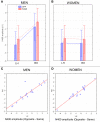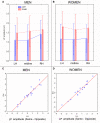Neural markers of opposite-sex bias in face processing
- PMID: 21833232
- PMCID: PMC3153781
- DOI: 10.3389/fpsyg.2010.00169
Neural markers of opposite-sex bias in face processing
Abstract
Some behavioral and neuroimaging studies suggest that adults prefer to view attractive faces of the opposite sex more than attractive faces of the same sex. However, unlike the other-race face effect (Caldara et al., 2004), little is known regarding the existence of an opposite-/same-sex bias in face processing. In this study, the faces of 130 attractive male and female adults were foveally presented to 40 heterosexual university students (20 men and 20 women) who were engaged in a secondary perceptual task (landscape detection). The automatic processing of face gender was investigated by recording ERPs from 128 scalp sites. Neural markers of opposite- vs. same-sex bias in face processing included larger and earlier centro-parietal N400s in response to faces of the opposite sex and a larger late positivity (LP) to same-sex faces. Analysis of intra-cortical neural generators (swLORETA) showed that facial processing-related (FG, BA37, BA20/21) and emotion-related brain areas (the right parahippocampal gyrus, BA35; uncus, BA36/38; and the cingulate gyrus, BA24) had higher activations in response to opposite- than same-sex faces. The results of this analysis, along with data obtained from ERP recordings, support the hypothesis that both genders process opposite-sex faces differently than same-sex faces. The data also suggest a hemispheric asymmetry in the processing of opposite-/same-sex faces, with the right hemisphere involved in processing same-sex faces and the left hemisphere involved in processing faces of the opposite sex. The data support previous literature suggesting a right lateralization for the representation of self-image and body awareness.
Keywords: ERPs; body awareness; face coding; hemispheric asymmetry; self-representation; sex differences; social cognition; visual perception.
Figures









Similar articles
-
Sex-differences of face coding: evidence from larger right hemispheric M170 in men and dipole source modelling.PLoS One. 2013 Jul 9;8(7):e69107. doi: 10.1371/journal.pone.0069107. Print 2013. PLoS One. 2013. PMID: 23874881 Free PMC article.
-
Neural activation during anticipation of opposite-sex and same-sex faces in heterosexual men and women.Neuroimage. 2013 Feb 1;66:223-31. doi: 10.1016/j.neuroimage.2012.10.068. Epub 2012 Nov 2. Neuroimage. 2013. PMID: 23128082
-
Women are better at seeing faces where there are none: an ERP study of face pareidolia.Soc Cogn Affect Neurosci. 2016 Sep;11(9):1501-12. doi: 10.1093/scan/nsw064. Epub 2016 May 5. Soc Cogn Affect Neurosci. 2016. PMID: 27217120 Free PMC article.
-
Neural and behavioral responses to attractiveness in adult and infant faces.Neurosci Biobehav Rev. 2014 Oct;46 Pt 4:591-603. doi: 10.1016/j.neubiorev.2014.08.015. Epub 2014 Sep 6. Neurosci Biobehav Rev. 2014. PMID: 25199981 Review.
-
Distributed and interactive brain mechanisms during emotion face perception: evidence from functional neuroimaging.Neuropsychologia. 2007 Jan 7;45(1):174-94. doi: 10.1016/j.neuropsychologia.2006.06.003. Epub 2006 Jul 18. Neuropsychologia. 2007. PMID: 16854439 Review.
Cited by
-
More than just two sexes: the neural correlates of voice gender perception in gender dysphoria.PLoS One. 2014 Nov 6;9(11):e111672. doi: 10.1371/journal.pone.0111672. eCollection 2014. PLoS One. 2014. PMID: 25375171 Free PMC article.
-
The menstrual cycle affects recognition of emotional expressions: an event-related potential study.F1000Res. 2017 Jun 8;6:853. doi: 10.12688/f1000research.11563.1. eCollection 2017. F1000Res. 2017. PMID: 28868136 Free PMC article.
-
Regional Brain Responses Are Biased Toward Infant Facial Expressions Compared to Adult Facial Expressions in Nulliparous Women.PLoS One. 2016 Dec 15;11(12):e0166860. doi: 10.1371/journal.pone.0166860. eCollection 2016. PLoS One. 2016. PMID: 27977692 Free PMC article.
-
Cerebral activity to opposite-sex voices reflected by event-related potentials.PLoS One. 2014 Apr 11;9(4):e94976. doi: 10.1371/journal.pone.0094976. eCollection 2014. PLoS One. 2014. PMID: 24727971 Free PMC article.
-
Gender differences in human single neuron responses to male emotional faces.Front Hum Neurosci. 2015 Sep 14;9:499. doi: 10.3389/fnhum.2015.00499. eCollection 2015. Front Hum Neurosci. 2015. PMID: 26441597 Free PMC article.
References
-
- Byatt G., Rhodes G. (2004). Identification of own-race and other-race faces: implications for the representation of race in face space. Psychon. Bull. Rev. 11, 735–741 - PubMed
LinkOut - more resources
Full Text Sources

